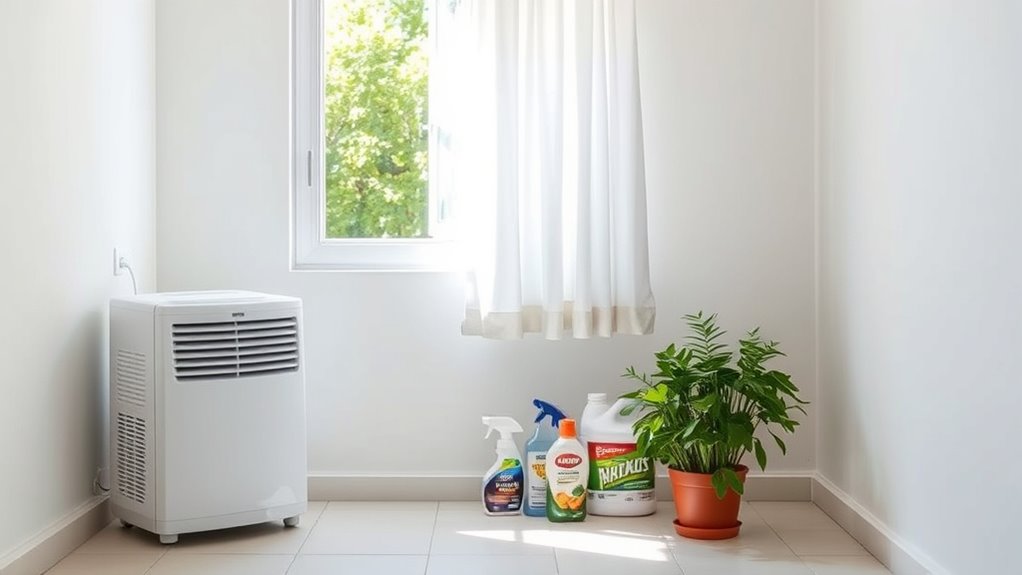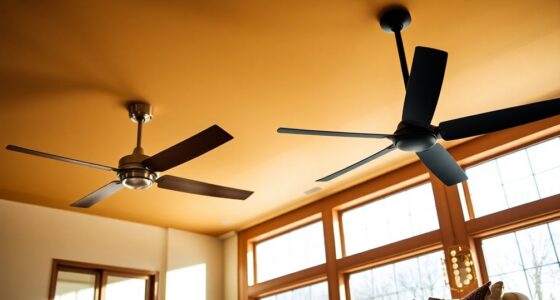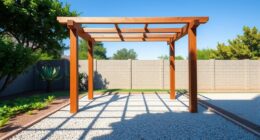To prevent mold in humid climates, keep indoor humidity levels between 30-50% using dehumidifiers and proper ventilation. Fix leaks immediately, improve airflow with exhaust fans, and use moisture barriers on floors and walls. Regularly inspect for water intrusion and clear out areas prone to dampness. Using mold-resistant paints and materials also helps. Implementing these strategies can substantially reduce mold risks—if you want to learn more about how to keep your home mold-free, keep exploring.
Key Takeaways
- Control indoor humidity levels between 30-50% using dehumidifiers and proper ventilation.
- Address leaks and water intrusion immediately to prevent moisture accumulation.
- Install moisture barriers behind walls and under floors in high-risk areas.
- Ensure proper drainage around the property and maintain well-maintained gutters and downspouts.
- Regularly inspect for mold, clean surfaces with mold-inhibiting solutions, and keep environments dry.
Understanding the Causes of Mold Growth in Humid Environments
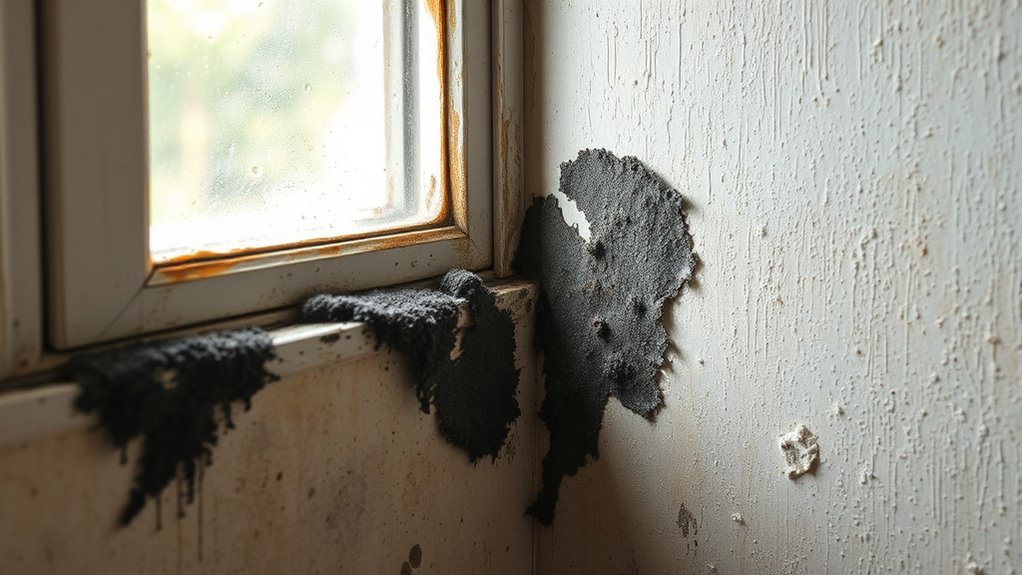
Mold needs moisture to thrive, so humid environments are prime conditions for its growth. To prevent mold effectively, you must understand the causes of mold growth in such settings. Humid environment challenges often include poor ventilation, leaks, and high indoor humidity levels, which create ideal conditions for mold spores to settle and spread. Proper ventilation can significantly reduce moisture buildup and inhibit mold development. Mold prevention strategies focus on reducing excess moisture and controlling humidity. This involves fixing leaks promptly, ensuring proper airflow, and addressing water intrusion immediately. Recognizing how moisture interacts with organic materials like drywall and wood helps you take targeted actions to minimize mold risk. By understanding these causes, you can implement effective prevention techniques, making your space less inviting for mold and protecting your health and property.
Keeping Humidity Levels Under Control
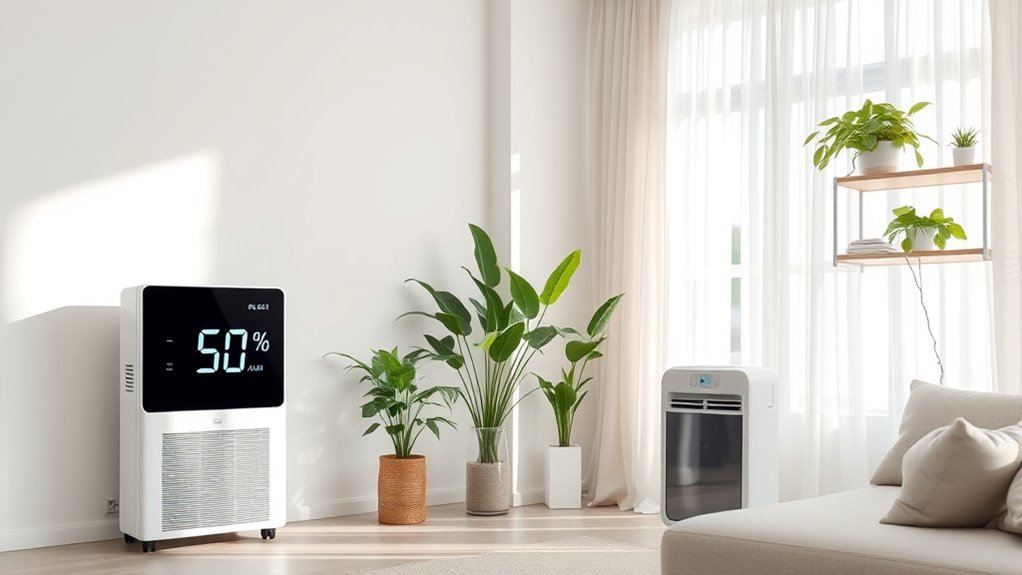
To keep mold at bay, you need to manage indoor humidity effectively. Using dehumidifiers, ventilating rooms properly, and monitoring humidity levels help create an environment that discourages mold growth. Taking these steps guarantees your home stays dry and mold-free. Additionally, keeping track of humidity with monitoring tools ensures optimal moisture levels are maintained consistently.
Use Dehumidifiers Effectively
Maintaining the right humidity levels is essential for preventing mold growth, and dehumidifiers are a practical tool to achieve this. To use them effectively, focus on proper dehumidifier placement—keep it in central locations away from walls or obstructions for even air circulation. Set your device to maintain suitable humidity levels, ideally between 30-50%. Regularly empty the water collection tank and clean filters to ensure efficiency. Use a hygrometer to monitor humidity levels and adjust the dehumidifier accordingly. Avoid over-drying the air, which can cause other issues. Additionally, consider cost and budgeting factors when choosing a dehumidifier, as options vary widely in price and features. By placing your dehumidifier correctly and maintaining ideal humidity, you create an environment less conducive to mold, protecting your home from moisture-related problems.
Ventilate Frequently and Properly
Regularly ventilating your home is one of the most effective ways to control humidity levels and prevent mold growth. Good airflow circulation helps remove excess moisture and stale air, reducing mold risk. Use exhaust fans in high-humidity areas like kitchens and bathrooms to enhance ventilation. To maximize effectiveness, consider these steps:
- Open windows daily to promote fresh air exchange.
- Turn on exhaust fans during and after activities that produce moisture.
- Ensure exhaust fans are functioning properly and cleaned regularly.
- Keep interior doors open to facilitate airflow throughout your home.
- Incorporate humidity control devices like dehumidifiers to further reduce moisture levels and discourage mold growth.
Proper ventilation reduces indoor humidity, discourages mold spores from settling, and keeps air fresh. Consistent airflow circulation and exhaust fan use are key to maintaining a healthy, mold-free environment.
Monitor Indoor Humidity Levels
Keeping indoor humidity levels in check is essential for preventing mold growth and maintaining a healthy home environment. Use humidity sensors to accurately monitor moisture levels, ensuring they stay between 30-50%. If readings are too high, reduce moisture sources, like drying laundry indoors or overwatering indoor plants. Indoor plants can help regulate humidity, but too many can increase moisture, so balance their presence. Regularly check sensors to catch fluctuations early and adjust your ventilation or dehumidification efforts accordingly. By actively monitoring humidity levels, you prevent conditions that promote mold growth. Keeping levels stable is key, especially in humid climates. Implementing proper ventilation practices can further help control indoor moisture and prevent mold development. With the right tools and awareness, you can create a less mold-prone environment and protect your home’s health.
Improving Ventilation Throughout Your Home

To effectively prevent mold growth, improving ventilation throughout your home is essential. Proper airflow patterns help remove excess moisture and reduce humidity. Use ventilation equipment like exhaust fans in bathrooms and kitchens to vent humid air outside. Consider these steps:
Enhance home ventilation with exhaust fans and proper airflow to prevent mold growth effectively.
- Ensure windows and vents are unobstructed to promote natural airflow.
- Install exhaust fans in high-moisture areas to exhaust humid air.
- Use ceiling fans to improve air circulation and prevent stagnant air.
- Maintain a consistent airflow pattern to avoid moisture buildup in corners and closets.
- Regularly monitor humidity levels to ensure they stay below 60%, which is crucial for mold prevention relative humidity control.
Using Dehumidifiers Effectively
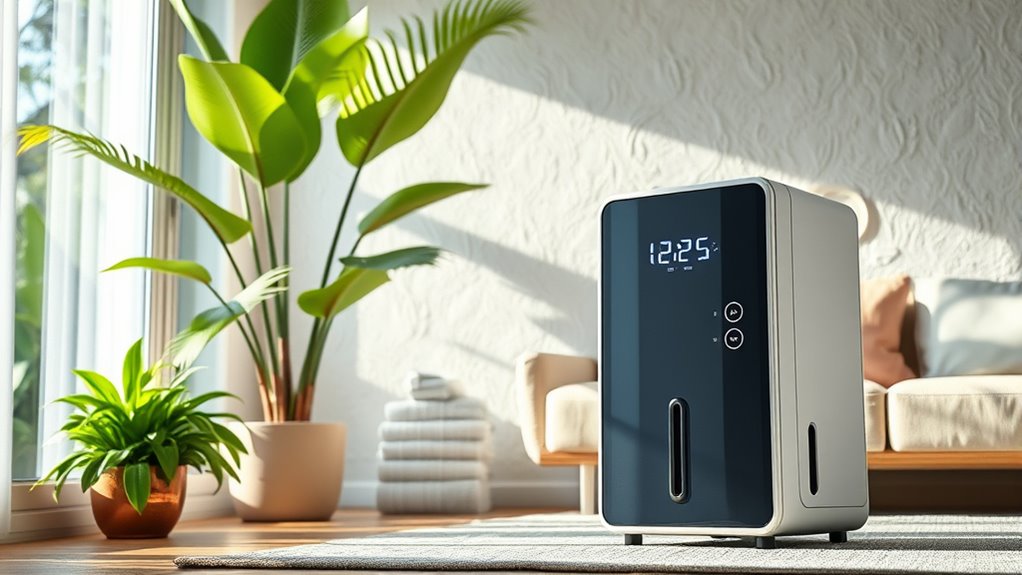
Using dehumidifiers effectively can considerably reduce indoor humidity levels, creating an environment less conducive to mold growth. To maximize their efficiency, focus on proper dehumidifier placement—place it in central locations away from walls and furniture to ensure good airflow. Keep doors and vents open so air circulates freely. Regular maintenance is key; clean the filters monthly and check for any buildup or leaks. Empty the water reservoir frequently or set up a drainage hose if your unit allows. Avoid overusing the dehumidifier, as excessive dryness can cause other issues. Maintain the recommended humidity level, typically between 30-50%. Proper device maintenance is essential to keep your dehumidifier functioning optimally and prevent mold. By following these maintenance tips and strategic placement, your dehumidifier will work effectively to keep moisture levels low and prevent mold.
Selecting Mold-Resistant Materials and Paints

Selecting mold resistant paints for walls, especially in high-humidity areas like bathrooms and kitchens, can significantly reduce mold growth. Opt for moisture resistant drywall instead of standard drywall in moisture-prone spaces. Use sealed, water-resistant flooring materials in areas prone to spills or dampness. Incorporate moisture barriers behind walls and under flooring to prevent hidden mold growth. Additionally, choosing air purifiers with HEPA filters can help remove airborne mold spores, further protecting your indoor environment.
Managing Water Leaks and Moisture Intrusions

Water leaks and moisture intrusions are common causes of mold growth, and addressing them promptly is essential for maintaining a healthy home. You should start with effective waterproofing techniques around vulnerable areas like foundations, basements, and roofs to prevent water from seeping in. Installing proper drainage solutions, such as gutters, downspouts, and French drains, helps direct water away from your home’s structure. Regularly check for cracks or damaged seals and repair them immediately to avoid leaks. Ensure that your landscaping slopes away from your foundation to reduce water pooling. Using moisture barriers on floors and walls in high-risk areas can also minimize intrusion. Additionally, practicing water management techniques can further reduce excess moisture that contributes to mold growth. By combining waterproofing techniques with efficient drainage solutions, you markedly reduce the risk of water-related mold issues inside your home.
Regular Cleaning and Maintenance Practices

Regular cleaning and maintenance are essential for preventing mold growth by removing dirt, dust, and organic material that mold feeds on. To stay ahead, focus on these key practices:
- Change air filters regularly to ensure proper airflow and reduce airborne spores.
- Clean surfaces with mold-inhibiting solutions to eliminate existing mold and prevent future growth.
- Implement pest control measures, since pests can carry mold spores and damage structures, creating entry points for moisture.
- Schedule routine inspections for leaks and moisture buildup, addressing issues promptly.
- Maintaining proper ventilation is crucial, as good airflow helps reduce humidity levels that promote mold growth.
Monitoring and Addressing Mold Early

Early detection is crucial in preventing mold from spreading and causing further damage. Regularly monitoring your home helps you spot signs of mold early, protecting your air quality and overall health. Use mold prevention techniques like checking damp areas, inspecting vents, and watching for musty odors. Pay attention to hidden spots such as behind furniture or beneath sinks, where mold can flourish unnoticed. When you notice any mold growth, address it immediately by cleaning with appropriate solutions and improving ventilation. Keeping humidity levels low and ensuring proper airflow are key steps to prevent mold from taking hold. By staying vigilant and acting swiftly, you reduce the risk of extensive damage, maintain better air quality, and support a healthier living environment.
Frequently Asked Questions
How Can Mold Affect Indoor Air Quality and Health?
Mold releases airborne spores that can considerably impact your indoor air quality. When you breathe in these spores, they may cause respiratory issues like allergies, asthma, or other breathing problems. Mold growth in your home can also worsen existing respiratory health conditions. To protect yourself, keep humidity levels low, fix leaks promptly, and ensure proper ventilation, reducing airborne spores and maintaining healthier indoor air for you and your family.
Are There Natural Remedies to Prevent Mold Growth?
Think of natural remedies as your garden’s guardians, quietly standing watch against mold. To prevent mold growth, you can use vinegar, tea tree oil, or baking soda—nature’s own warriors—sprayed in problem areas. These mold prevention allies fight dampness and inhibit mold spores from taking root. With consistent care, you create a barrier of natural defenses, keeping your home fresh and mold-free without harsh chemicals.
Can Plants Help Reduce Humidity and Mold Risk?
Plants benefit your home by improving humidity control, which can help reduce mold risk. When you place certain indoor plants, they absorb excess moisture from the air, making your environment less humid. This natural method supports mold prevention without chemicals. You can choose plants like peace lilies or Boston ferns, which thrive in humid conditions and actively help control humidity levels, creating a healthier living space for you.
What Are the Signs of Hidden Mold Behind Walls?
You might notice hidden mold behind walls if you see musty odors, peeling paint, or bubbling drywall. Wall moisture can cause mold growth that isn’t immediately visible, so keep an eye out for discoloration or warping. Sometimes, you’ll find hidden mold only when you inspect closely or when professional testing reveals it. Addressing wall moisture promptly prevents mold from spreading and causing health issues.
How Often Should I Inspect for Mold in Humid Climates?
Think of your home as a garden that needs regular tending. In humid climates, you should inspect for mold at least once every three to six months. Keep inspection frequency in mind, especially after heavy rains or humidity spikes. Pair this with consistent moisture monitoring around windows, pipes, and basements. Staying vigilant helps catch hidden mold early, preventing bigger problems down the line.
Conclusion
By staying vigilant and taking proactive steps, you can outsmart mold before it takes hold. Keep an eye on humidity levels, fix leaks promptly, and maintain good ventilation. But don’t let your guard down—mold can hide in unexpected places. The next warning sign could be just around the corner. Are you prepared to catch it early and protect your home? Stay alert, and mold won’t stand a chance.
